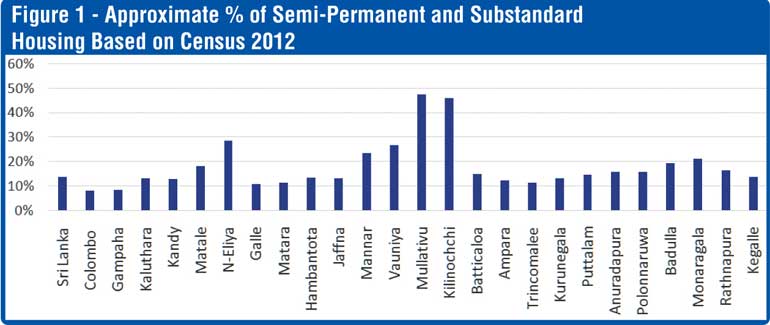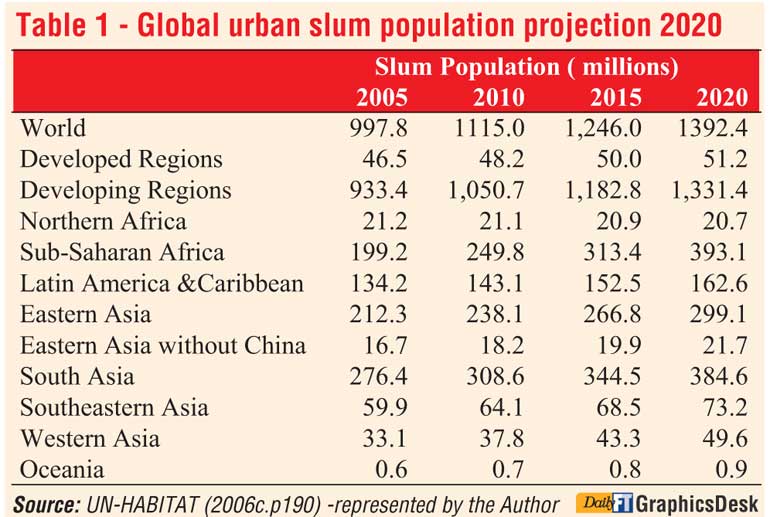Wednesday Dec 03, 2025
Wednesday Dec 03, 2025
Tuesday, 4 October 2016 00:01 - - {{hitsCtrl.values.hits}}
Housing is a critical component in economies and human development process. However, housing provision has been an acute problem in the most countries. Today across the world people are celebrating World Habitat Day with the objective of reflecting the state of their housing, and to promote the importance of everybody has an access to adequate housing and people’s right to a decent house to live as a basic human need. Drawing attention on positive changes in the systems including policies and peoples attitude for decent housing one of other objectives. Habitat Day also aims to remind the world the joint responsibility for sustaining the habitability of future generations
The right to adequate housing
Everyone on the earth has a right to an adequate standard of living. Nevertheless, in today’s context of globalisation and the free market economy, there is a trend towards greater competition and market efficiency, which often results in increased marginalisation of the poor from essential facilities. This entailed to recognise adequate housing as a human right. This development in the international human right law, underlies a strong background for the expansion of housing system and housing finance and mortgage markets across the world. Broader sagacity on the right to adequate housing is therefore critical for developing housing and housing finance initiatives in any economy, to economically weaker group in particular.
The right to adequate housing is recognised in international human rights law as a component of the right to an adequate standard of living. As per the UN Covenant of Economic Social and Cultural Rights, ‘everyone has the right to an adequate standard of living for him/herself and his/her family, including adequate food, clothing and housing, and to the continuous improvement of living conditions, and governments must take appropriate steps to ensure progressive realisation of this right’. The human right to adequate housing is central to the enjoyment of all other economic, social and cultural rights, and applies to everyone.
The right to adequate housing has received universal recognition since the adoption of the Universal Declaration on Human Rights in 1948, and has been reaffirmed and reinforced by many international human rights texts and policy-oriented instruments. Among them, the UN International Covenant of Economic Social and Cultural Rights, is widely considered as the central instrument for the protection of the right to adequate housing
 The right to adequate housing has been a key topic at the UN Habitat agenda which highlights the steps required to be taken by governments to “promote, protect and ensure the full and progressive realisation of the right to adequate housing”. At the Habitat meeting 2001, known as Istanbul +5, steps were taken to establish the UN Human Settlement Programme, known as UN-HABITAT to promote the right to housing in cooperation with the Office of the High Commissioner for Human Rights. UN-HABITAT is the most important international forum setup for the promotion of the right to adequate housing worldwide.
The right to adequate housing has been a key topic at the UN Habitat agenda which highlights the steps required to be taken by governments to “promote, protect and ensure the full and progressive realisation of the right to adequate housing”. At the Habitat meeting 2001, known as Istanbul +5, steps were taken to establish the UN Human Settlement Programme, known as UN-HABITAT to promote the right to housing in cooperation with the Office of the High Commissioner for Human Rights. UN-HABITAT is the most important international forum setup for the promotion of the right to adequate housing worldwide.
Components of the right to adequate housing
The United Nations Committee on Economic, Social and Cultural Rights has featured that the right to adequate housing should not be interpreted narrowly. Rather, it should be seen as the right to live somewhere in security, peace and dignity. The characteristics of the right to adequate housing are clarified mainly in the Committee’s general comments No.4 (1991) on the right to the adequate housing and No. 7 (1997) on forced evictions. Some of the important features specified in the UN- HABITAT Fact Sheet No.21, on The Right to Adequate Housing is as follows.
The right to adequate housing contains freedoms. These freedoms include; the right to choose one’s residence, to determine where to live and to freedom of movement, protection against forced evictions and arbitrary destruction and demolition of one’s home and , the right be free from arbitrary interference with one’s home privacy and family.
The right to adequate housing contains entitlements. These entitlements include; security of tenure, housing, land and property restitution, equal and non-discriminatory access to adequate housing, participation in housing-related decision-making at the national and community levels.
Housing must provide more than four walls and a roof. Number of conditions must be met before a particular form of shelter to be considered to constitute an adequate housing. These elements, (a) Availability of services and infrastructure, (b) Affordability, (c) Accessibility, (d) Legal security of tenure, (e) Habitability including physical safety, adequate space, and protection against the heat, cold, damp, rain, wind etc., (f) Location and, ( g) Cultural adequacy.
The housing right also contains the right to protection against forced evictions which is a key element linked to security of tenure.
The right to adequate housing also contains the right to be non-discriminatory. In housing, discrimination can take the form of discriminatory policies, zoning regulations, exclusion from housing benefits, denial of security of tenure, lack of access to credit, limited participation in decision making, etc.
The right to adequate housing of specific groups. To protect the housing right effectively it is necessary to pay attention to specific situations of individuals and groups. In particular those who are in vulnerable situation. Those groups include women, children, persons with disabilities, elderly people, displaced people, migrants, indigenous people etc.
Inadequate housing and increasing homelessness
Since recognition of the right to adequate housing by the global legal system, most of countries have articulated the underlined principles in developing their housing and housing finance polices and have been successful in managing housing challenge. Many success stories are available in East Asian Region. Nevertheless, over 60 years after recognising the right to adequate housing by the global legal system, the world is still facing an increasing housing crisis in general. Housing as a problem is not unique to any region or economic cluster in the world. There is hardly any country whether developed or under developed in the world today which can justly claim to have solved this problem. Arguably, all countries whether developed or developing face this challenge at different magnitudes.
As per UN-HABITAT, approximately 1.6 billion people worldwide are living in substandard housing and almost 100 million homeless. The most acute issue in global housing challenge is increasing trend of urban slum settlements. As quoted by the UN-HABITAT’s global report on human settlements 1996, about 500 million urban dwellers were homeless or lived in inadequate housing in1995. After 20 years, the estimated figure is 1,246 million (2015) showcases an alarming increase of over 7.5% per annum. Within the period between 2001 and 2010 the slum situation has increased by 22% and the projected expansion between 2010 and 2020 is 25%, mainly driven by developing regions. Developing regions face the biggest challenge of urban informal settlers, given accumulated figure of 94 per cent of global slum population. (Table 1)
As per UN-HABITAT, access to adequate housing is a growing problem in a majority of countries in South Asia. Estimated 344.5 million urban population live in informal settlements characterised by poor construction, insecure tenure, and underserviced housing plots in 2015, representing almost 28% of the world urban slum population (Table 1). These trends are set to continue in the coming decade and by 2020 the urban slum population in South Asia is predicted to reach nearly 384.6 million. Taking into account the projected average household size in South Asia (3.5 persons per household, estimate 2020) this will translate to a new affordable housing market of 110 million units between 2015 and 2020.
In India, 104.7 million urban people, approximately 29.4% of urban population live in inadequate housing, in Bangladesh 61.6%, Nepal 58.1 % (Table-2). Out of 15% urban population in Sri Lanka, approximately 4.8% live in slums or shanties. In the district of Colombo, out of 55% urban population, 8% residents are poorly housed. These data reveal that in Sri Lanka, the urban slum challenge is fairly more manageable than in regional counterparts.
In general terms, the worse urban housing shortages in South Asia are hiding behind squatter settlements and higher persons-per-room densities. As per the World Bank, the average persons per room count in urban areas is over 3.5 persons in India and Pakistan. That density is comparable regionally, but worse than in developed countries: density is 0.5 persons per room in the United State and 1.1 in the European Union. Density in Sri Lanka is an outlier at 1.1 persons per room. However, 20+million population in Sri Lanka also face a significant housing challenge in general.
This information evidences how the problem is getting worse worldwide. This is mainly because housing development does not keep up with the rate of growth of urban population. As per Global Housing Strategy Framework 2013, UN-HABITAT, currently, the world’s urban population is growing 2.5 times faster than the rural population. Urban population which was 2.4 billion in 1995 is projected to reach five billion in 2025. In 2007, for the first time in history, more people were living in cities and towns than in rural areas. By 2050, 70% of the world’s population is projected to be living in urban areas. Thus, despite the significant efforts that have served to improve the living conditions of 230 million slum dwellers, since 2000, the net growth of slums continues to outpace the improvement. This showcases the continuous pressure of housing need with the present-day realities.
Misconceptions about the right to adequate housing.
In the route of ensuring adequate housing for every household, clear understanding of the underlined thought of the right to adequate housing could play a great supportive role. A wealth of research has revealed that misconception of the right to adequate housing among the stakeholders has impeded realisation of the right to adequate housing to a greater extent across all countries. These misconceptions fuel the rising housing challenge to a significant extent, in the developing world particularly. Housing and housing finance industries as important supportive industries often encounter challenges due to these misconceptions. Sometime it becomes a severe impediment for implementation of vital economic development initiatives and projects. Some of the common misconceptions often encountered are as follows (UN- Habitat Fact Sheet No.21, on The Right to Adequate Housing).
Misconception that the government should provide housing. The right to adequate housing does not require the government to provide housing for the entire population, and people without housing cannot demand housing from governments. Governments’ responsibilities cover measures that are needed to prevent homelessness, address discrimination, focus on the most vulnerable and marginalised groups, ensure security of tenure to all, and guarantee that everyone’s housing is adequate. These measure can requires intervention of the government at various level, legislative, administrative, policy, etc. It can be implemented through an enabling approach to shelter rather than playing the role of housing provider.
However, in specific situations, the government is required to provide direct assistance, including housing or housing allowances, notably to people affected by disasters (natural or man-made) and to the most vulnerable groups in the society.
The right to adequate housing does not impose an immediate obligation on the government. On the contrary, it should be a programmatic goal. States must make every possible effort progressively, within the available resources to realise the right and to take steps in that direction without undue delay.
Another misconception is that the protection against forced evictions can prohibit development projects. There are inevitable needs for the redevelopment of certain properties, areas in growing cities and for public agencies to acquire land for public use and development of infrastructure that entail displacements. The right to adequate housing does not prevent such development or modernisation projects from taking place, but impose conditions and procedural limits on implementation.
It is sometimes believed that the right to adequate housing equate to right to property or land. The right to adequate housing is broader than the right to own property as it addresses rights not related to ownership and is intended to ensure that everyone has safe and secure place to live in peace, and dignity, including non-owners of property. Security of tenure is the cornerstone of the right to adequate housing which can take a variety of forms, including rental accommodation, lease, owner-occupation, emergency housing or informal settlements.
The right to adequate housing requires sustaining access to services. There must be access to services such as safe drinking water, energy, cooking facilities, sanitation, refuse disposal, site drainage and health services etc. Sustainable and non-discriminatory access to these services is one of the most important component of the right to adequate housing which is not fully understood by the most house owners and developers.
Habitat agenda post 2016
The housing challenge in Sri Lanka is in much manageable level than the regional counterparts. Over the last 30 years the country has been successful in managing national housing shortfall and presently over 99% of households have shelter of either owned or rented or encroached of diverse quality standards. Only 13% of the housing stock is semi-permanent, whereas in India 45%, Bangladesh 50% (World Bank). Only 4.8% of urban population live in inadequate housing, whereas in Bangladesh 61.6%, India 29.4% (Table 2). On the other hand in terms of basic housing services Sri Lank ranks highest in the region (Table 3). Nevertheless we observe a significant regional disparity in the distribution of adequate housing (Figure 1).
The post-2016 housing agenda should focus on minimising this regional disparities while facilitating the housing need of growing middle income market. Above middle income housing market is self-driven by own construction and market housing and substantially fuelled by the banking system. The Government is in correct direction and has taken initiatives in improving regional low income housing by giving micro level home improvement credit facilities at subsidised interest rate. The Government also has taken steps facilitating construction of 500,000 units of middle income apartments by providing lands and necessary infrastructures. However to speed up the results and effectiveness of these programs stakeholders’ sagacity of due responsibilities and obligation on the right to adequate housing is important in the current day reality.
In the route of driving the habitat agenda post 2016, structured mechanism for all stakeholders’ communication, engagement and education on due responsibilities and rights for adequate housing is important in the increasingly-complex environment. Good governance and transparency are vital in improving industry sustainability and affordability of housing to needy groups. Close cooperation and coordination among the large number of institutions involved in the sector is needed to speed up the process. One apex body could play a better role.
(The writer, MBA, BSc, FCA, FCMA, is Chief Finance Officer, HDFC Bank of Sri Lanka. The sources of estimates and figures in this article, unless otherwise mentioned are as per the market research and analysis of the author and views does not necessarily represent that of HDFC Bank of Sri Lanka. Email: [email protected].)



